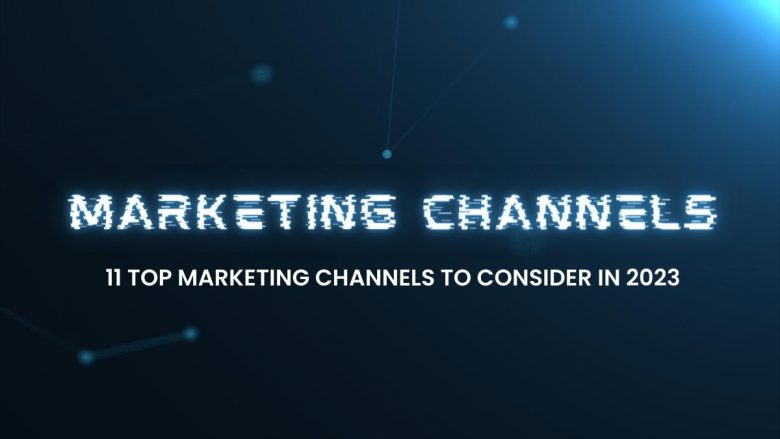
Marketing is one of the most important tasks for any business. It’s how you get the word out about your product or service, build relationships with customers and increase sales. With numerous marketing channels available, it can be difficult to know which ones are best for your business. To help you make an informed decision, this article will discuss 11 top marketing channels that businesses should consider. We’ll examine each channel in-depth, including its key benefits and potential drawbacks.
1. Organic Search
Organic search is one of the top marketing channels for businesses of all sizes. For those looking to increase their online presence and visibility, organic search should be a top priority. Investing in organic search optimization can provide significant ROI and lead generation opportunities, making it an invaluable part of any business’s marketing mix.
Organic search engine optimization (SEO) focuses on improving a website’s ranking on SERPs (search engine results pages). By optimizing content, titles, metadata, and other elements, companies can improve the quality of their site and move up in rankings to compete with other leading sites. Good SEO practices also include making sure that websites are optimized for both mobile and desktop devices, as well as ensuring that pages load quickly and accurately.
2. Social Media
Social media is quickly becoming one of the top marketing channels for businesses today. With over 3 billion people on social media platforms, it provides a unique opportunity to reach large numbers of interested customers. Businesses are taking advantage of this powerful channel by utilizing strategies such as creating engaging content and leveraging user data to target ads better.
The benefits offered by social media make it an ideal platform for businesses looking to increase their reach. Companies can use social media to create relationships with their customers and promote brand awareness in new markets. Additionally, they can measure their success with analytics tools that provide valuable insights into the effectiveness of their campaigns. This helps them optimize their efforts and maximize returns from their investment in social media marketing.
3. Video Marketing
Video marketing has become one of the top marketing channels for businesses of all sizes. It is an effective way to get your message out, capture a wider audience, and build brand recognition. It allows you to reach more people without relying solely on traditional advertising methods such as radio and print media.
Using video as a marketing strategy can help to increase customer engagement, drive website traffic, generate leads, boost sales and improve SEO rankings. Video content can also be used to showcase products in an engaging way that encourages viewers to take action. Additionally, video can be utilized for educational purposes to demonstrate how certain processes work or explain new concepts in detail. This type of content will increase brand loyalty by making customers feel like they can trust your product or service.
4. Advertising
Advertising is one of the oldest and most essential marketing channels available to businesses. It has been used for decades to reach large audiences and build brand recognition to increase sales. When using advertising as a top marketing channel, businesses must carefully consider their objectives and target audience to make sure they are leveraging the power of this tool effectively.
Various types of advertising can be used, including print (such as newspapers, magazines, and billboards), television and radio broadcasts, direct mail campaigns, or even online campaigns like PPC ads or social media posts. The key is understanding which mediums best suit your business needs and how you can use them to maximize your visibility in the marketplace. Additionally, the budget will be an important factor as different platforms come with varying costs associated with them depending on the level of reach you desire.
5. Email Marketing
Email marketing is one of the top channels available to marketers today. It’s an incredibly effective tool for reaching a wide audience and engaging with customers. With email, you can reach people on any device and at any time, making it a great way to get your message out there without having to worry about other mediums like television or radio.
By leveraging email marketing, businesses can easily target their ideal customer. You can create segmented lists based on demographics and interests, which allows you to send personalized emails that will be more likely to resonate with your audience. Additionally, email has one of the highest ROI rates compared to other forms of digital marketing; research shows that for every dollar spent on email campaigns, companies see an average return of USD 42 in sales revenue. That makes it one of the most cost-effective forms of marketing available today.
6. Sponsorship
Sponsorship is one of the top marketing channels for businesses to reach their target audience. It offers a unique opportunity to align brands with desirable consumer events, experiences, and personalities while providing an effective way to create visibility. By utilizing strategic sponsorship partnerships, businesses can quickly establish brand awareness and build consumer loyalty.
When choosing sponsorship opportunities, it’s important to consider the type of event or person that will best amplify your message. For example, if your business focuses on children’s health food products then sponsoring a youth sports team would be well-suited. Similarly, if you are in the fashion industry then sponsoring a local fashion show may be beneficial in increasing brand recognition among consumers.
With thoughtfully chosen sponsorships, companies can get their message across through targeted campaigns without spending too much money or resources.
7. Conversational Marketing
Conversational marketing has become one of the top marketing channels for businesses. It’s a way for companies to engage with their customers by interacting with them in real-time chats and conversations. By creating an open dialogue between a business and its customers, companies can gain valuable insights into how they can better serve their customers and create more personalized experiences.
The technology behind conversational marketing also allows businesses to provide more timely responses and solutions to customer inquiries. This helps ensure that customers are receiving the best possible service while also helping businesses maintain stronger relationships with their customer base. Additionally, conversational marketing is cost-effective, making it an attractive option for businesses looking to maximize their budget without sacrificing quality or effectiveness.
8. Word of Mouth
Word of mouth is one of the oldest and most effective forms of marketing. Known as one of the top marketing channels, word of mouth has been used since ancient times to promote businesses, products, and services. It is a powerful tool that businesses should not ignore when planning their marketing strategies.
Word of mouth happens naturally when people are satisfied with a product or service they have received and share it with others in their network. It can be amplified through customer referral programs where customers are rewarded for referring new customers to your business or sharing content on social media platforms. Word of mouth can also be generated through influencers who can amplify your message further by leveraging their own social networks.
Whatever approach you decide on, make sure that your product or service is high quality so that it encourages positive word-of-mouth recommendations from your customers.
9. Podcasts
Podcasts have become one of the top marketing channels in recent years, with more and more businesses turning to them as a way to reach their audiences. Whether you’re looking to build relationships with customers or increase brand awareness, podcasts can be a great way to do it. Not only are they cost-effective, but they also provide an engaging platform for people to learn about your business and products.
Podcasts offer several advantages over traditional advertising methods. They are highly targeted and allow you to reach a specific audience segment quickly, without the need for expensive production costs or complicated distribution processes. Additionally, podcast content is often easier for listeners to digest than text-based mediums like printed materials or online articles. As a result, podcasts can be incredibly powerful tools for building brand loyalty and boosting customer engagement levels.
10. Events
Events are one of the top marketing channels for businesses of all sizes. Holding events is a great way to connect with new and existing customers, boost brand recognition, and generate leads. It allows potential customers to experience your business firsthand and connect with you in person.
When planned strategically, events can be incredibly successful as they allow companies to engage with their target audience in a meaningful way. Through onsite activities, interactions, and giveaways, event attendees learn more about a company’s mission and services while deepening their connection with the brand. Additionally, events offer businesses the ability to network with other industry professionals which can lead to valuable partnerships down the line.
11. Affiliate Marketing
Affiliate marketing is quickly becoming one of the top marketing channels for businesses. It has the potential to generate long-term, passive income streams for businesses and individuals alike. By leveraging a network of affiliates to help promote their products or services, companies can reach a larger audience than ever before.
Affiliate marketing enables businesses to partner with affiliates who will market their product or service on their behalf in exchange for a share of the profits. This means that companies don’t have to invest heavily in advertising and promotion – they simply pay an agreed percentage of sales generated by affiliate partners. Plus, these agreements are often structured on a performance basis, so there’s no risk involved since affiliates only get paid when they make sales. This makes it an attractive option for both sides; not only do companies benefit from increased exposure and sales opportunities but also affiliates benefit from additional revenue streams and commissions.


